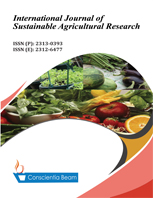Bioaccumulation of zinc in rice (oryza sativa l.) from River Swat, Panjkora, And Kabul Pakistan
DOI:
https://doi.org/10.18488/ijsar.v10i3.3532Abstract
Ecosystem contamination with heavy metals lead to the bioaccumulation of these elements in crops. Rice, a significant component of the human diet, can bioaccumulate heavy metals and is of public health concerns. Therefore, the current research aimed to investigate the bioaccumulation of the heavy metal zinc in several rice varieties from three rivers in Pakistan's Malakand Division. The Highest Zn concentration of 91.58± 6.25 mg kg−1 dry weight was observed in rice roots of China Basmati variety grown across River Swat, while the highest Zn concentration of 60.06 ± 4.41 mg kg−1 dry weight was observed in the stem of Mota Chawal on River Kabul. In a site-wise comparison of both River Swat and Kabul, the Zn concentrations in the stem of Sara Sela rice on River Panjkora were 55.5±4.37, showing significant differences among different sites on the rivers. Similarly, comparing metal concentrations in different rice varieties generally did not show significant differences between the varieties. Zn concentrations in rice were higher in the Swat River than in the rest in all cases. Bioaccumulation factor (BAF) values for Zn were in the order of soil > roots > stem > leaves > grains for River Swat and Kabul. In contrast, for River Panjkora Zn concentration, the order was soil > stem > root > grains> leaves, respectively. Zn absorption by rice in the form of ions or particles generally affects plant phenotypic, physiological, and molecular development; hence, it must be considered in present varieties for the future.

